![]()
![]()
THE MIGRATORY PATHS OF THE INDO-EUROPEANS
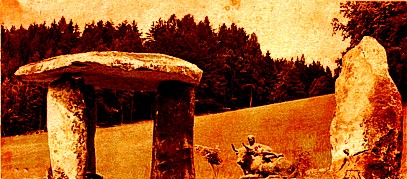
by Thomas V. Gamkrelidze and V. V. Ivanov
Scientific American, March 1990, P.110
In the 2,000 years before the Indo-Europeans who remained in the homeland began to write history, the success of the agricultural revolution brought a population explosion to the Indo-European community. The pressure of population, we may surmise, compelled the migration of successive waves of Indo-Europeans to fertile areas that were not yet cultivated.

AN ARMENIAN WARRIOR'S SOLAR SIGIL
[LIT. UR FORCE]
CARVED ON THE HANDLE OF HIS SWORD
SECOND MILLENNIUM BC.
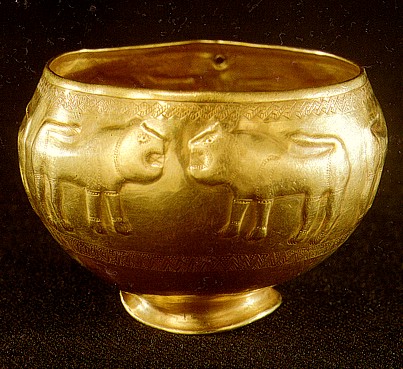
A CUP OF PURE GOLD WITH TWO LIONS FACING [BATTLING] EACH OTHER.
VANADZOR. 1,700 BC.
The linguistic translocation of the Indo-European homeland from northern Europe to Asia Minor requires drastic revisions in theories about the migratory paths along which the Indo-European languages must have spread across Eurasia. Thus, the hypothetical Aryans who were said to have borne the so-called Aryan, or Indo-Iranian, language from Europe to India—and who were conscripted into service as the Nordic supermen of Nazi mythology—turn out to be the real Indo-Iranians who made the more plausible migration from Asia Minor around the northern slopes of the Himalaya Mountains and down through modern Afghanistan to settle in India. Europe is seen, therefore, as the destination, rather than the source, of Indo-European migration.

FOUR Ēs [SEVENTH
SACRED ESSENTIAL LETTER]
UNITING TERRESTRIAL WITH THE CELESTIAL

FERTILITY RITES DURING SPRINGTIME. DECORATING THE T R E E
O F L I F E
BY TYING RIBBONS ON VARIOUS BRANCHES
[THE TRADITION EVOLVED INTO
THE CHRISTMAS TREE].
THE FRUITS AND FLOWERS ARE SYMBOLS OF LIFE.
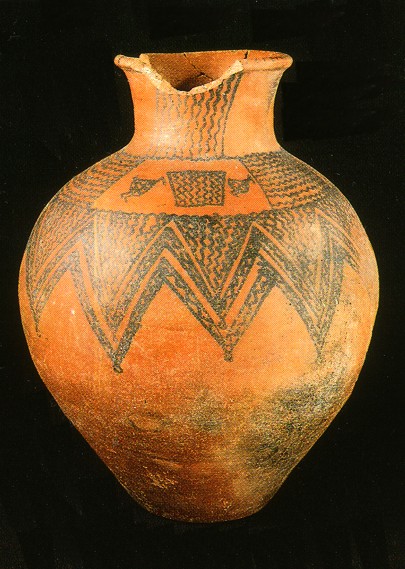
KARAS [JAR] RED POLISHED CERAMIC. 2,000 BC. ARUCH.
NOTE THE PERPENDICULAR AND PARALLEL --VERTICAL AND HORIZONTAL --
'SOFT' WAVES AND THE 'HARD' TRIANGULAR ZIGZAG LINES.
TWO [LOVE]BIRDS WITHIN A TRAPEZOID.
Speakers of the Hittite, Luwian and other Anatolian languages made relatively small migrations within the homeland, and their languages died there with them. The more extensive migrations of speakers of the Greek-Armenian-Indo-Iranian dialects began with the breakup of the main Indo-European language community in the third millennium B.C. Two groups of Indo-Iranian speakers made their way East during the second millennium B.C. One of them, speakers of the Kafiri languages, survives to this day in Nuristan, on the southern slopes of the Hindu Kush in northeast Afghanistan. In Five Continents, a posthumous book recounting his many botanical expeditions between 1916 and 1933, Vavilov speculated that the Kafirs might perpetuate some "original relics" of Indo-Iranian.

COSMIC ARMIN SYMBOLS OF THE SUN, LIFE, FERTILITY, BIRTH-REBIRTH
[REGENERATION], MOTHER NATURE-EARTH ...AND...ETERNITY.
THE INDO-EUROPEANS SPREAD RAPIDLY
THROUGHOUT THE ANCIENT WORLD
WITH THE HELP OF THEIR CHERISHED STEEDS

KINGDOM OF ARARAT.
HORSE 'S HEAD. A REMNANT OF A LARGER STATUE.

ARMANI COSMIC SYMBOLS PLACED
ON OBJECTS LARGE AND SMALL.
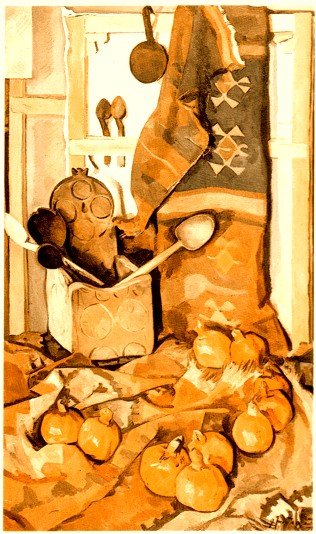
TIME IMMEMORIAL ARMANI SYMBOLISM BY THE GREAT
G. KHANJIAN...THE SACREDNESS OF LIFE.
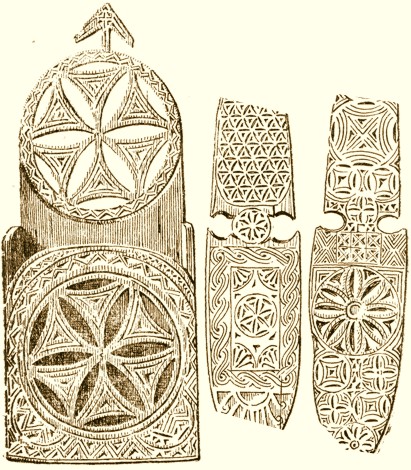
ARMENIAN COSMIC SYMBOLS [ABOVE EXAMPLES ARE SURVIVING WOOD
WORKS FROM MIDDLE AGES...DUE TO ORGANIC NATURE OF WOOD
ONLY FEW ITEMS FROM A COUNTLESS ARRAY HAVE BEEN PRESERVED]
DISPLAYING DISTINCT MITHRAIC-SOLAR NATIONAL CHARACTER]
PLACED FROM TIME IMMEMORIAL ON ITEMS OF
SPECIAL MEANING AND SIGNIFICANCE IN AN UNBROKEN TRADITION
THE MILLENNIA OLD NATIONAL ART AND CRAFT IS TODAY THRIVING.

PRESERVED BEER MUG FROM THE MIDDLE AGES
[ARCHAIC ARMAN SYMBOLS] WITH INTRICATE
WOOD CARVING PATTERN.

WARRIOR'S DRINKING GOBLET IN THE FORM OF A BULL [TAURUS]
MADE
OUT OF DEER'S [FEM. PRINCIPLE] HORN.
The second group of Indo-Iranians, who followed a more southerly path into the Indus Valley, spoke a dialect from which the historical languages of India are descended. Their earliest literary ancestor is embodied in the Rig Veda hymns, written in an ancient variant of Sanskrit. The indigenous peoples of the Indus Valley, known from the archaeological discoveries at their capital Mohenjo-Daro, were apparently displaced by the Indo-Iranians.

KINGDOM OF ARARAT
DRINKING GOBLET.
After the separation of the Indo-Iranians and their departure for the east, the Greek-Armenian community remained for a time in the homeland. There, judging by the numbers of loan words, they had contact with speakers of Kartvelian, Tocharian and the ancient Indo-European languages that later evolved into the historical European languages. One such borrowing from the Kartvelian became the Homeric koas, "fleece."

LIFE, NATURE AND UNIVERSE IN MOTION.

TRADITIONAL SPOONS MARKED WITH REVERED ELEMENTAL
SIGNS OF LIFE AND WELL-BEING [CONSECRATING THE MEAL].

DECORATION FROM TEYŠEBAINI.
SEVEN SPIRALING RINGS AROUND
ONE POINT IN A CIRCLE.
SECOND MILLENNIUM B.C.
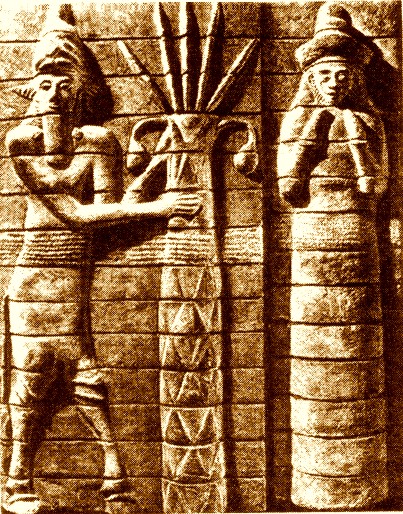
ARMENIC GODDESS NINHURSAG WITH THE SPIRIT OF THE FORESTS
[MAN-TAURUS] NEXT TO THE SEVEN [FIVE POINTING UPWARD AND
TWO DOWN] SPIKED COSMIC TREE OF LIFE. NOTE THE UNITED TRIANGLES
[UNION OF OPPOSITES]. RELIEF FROM SUSA. SECOND MILLENNIUM BC.

A CERAMIC POT WITH THE SUPERIMPOSED CARVING OF TWO-HEADED
VIŠAP [THE TWINS OR DUALITY FROM THE SINGLE
SOURCE]
[DRAGON OR SERPENT BITING ITS OWN TAIL [ETERNITY].
METSAMOR [LIT. GREAT MOTHER'S]. SECOND MILLENNIUM BC.

TALISMAN OF PROTECTION OF ARMAN WARRIOR.
LCHASHEN, GEŁARK‛UNIK‛. SECOND MILLENNIUM BC.

SACRED RITE OF PURIFICATION IN THE FREE
SPIRIT OF THE FORREST. CHALDEAN
ORACLE KURM SEERS AND GUARDIANS OF THE ETERNAL FLAME OF WISDOM.
A bilingual cuneiform tablet found in the Hattusas archives records the mythological tale of a hunter in the then already dead Hurrian language along with a translation into Hittite. This remarkable discovery gave us the Hurrian word ashi from which Homer's askos, for "hide" or "fur," apparently stemmed. Before their migration to the Aegean, the Greeks borrowed the Hittite word kursa, which by a familiar phonological shift became bursa, another synonym for "fleece."
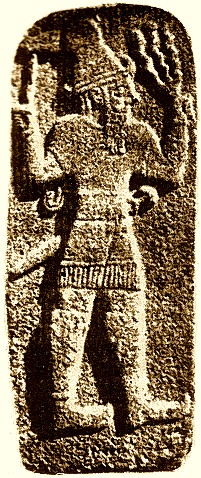
RELIEF OF
T E I Š E B A THE SKY GOD OF
THUNDER.
IN HIS RIGHT HAND HE CARRIES THE HAMMER/AXE
OF DESTINY AND IN HIS LEFT HAND HE HOLDS THE
LIGHTNING RODS ['TRIBOLT']. HE ALSO CARRIES
THE SWORD OF VICTORY -- A PHALLIC SYMBOL
DENOTING FERTILIZATION OF LAND WITH RAIN
AND THUNDER FROM ABOVE. SECOND MILLENNIUM BC.

THE REMARKABLE BOWL OF SUPERB CRAFTSMANSHIP BY ARMENIAN
SILVERSMITHS
FROM K‛ARAŠAMB
ON DISPLAY ALONG WITH MANY PRICELESS, UNIQUE HISTORICAL
ARTIFACTS OF GLOBAL PROPORTIONS IN THE STATE HISTORY MUSEUM OF ARMENIA --
IN THE REPUBLIC SQUARE, THE HEART OF THE ARMENIAN CAPITAL XXII-XXITH
CENTURIES BC [END OF THIRD MILLENNIUM BC].

ARMIN SOLAR BRACELET. SECOND MILLENNIUM BC.
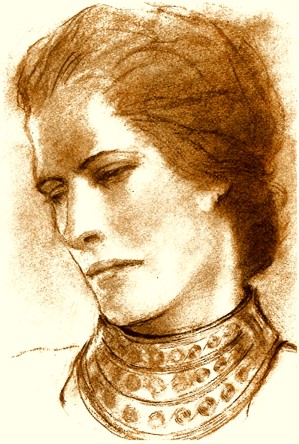
SPIRALS OF NOBILITY AND POWER WORN BY ARMANEN
NOBLES ON ELEGANT JEWELRY.
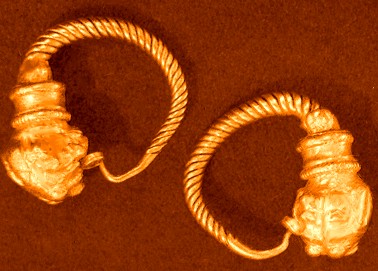
SET OF NUMEROUS GOLDEN [OR/AR/UR/ER/IR] EARRINGS [TWO
RINGS...8]
NOTCHES LEADING TO THE HEAD/CORONA...[TESNEL/SEE/PSYCHE/
CLAIRVOYANCE + MUSE/CLAIRAUDIENCE...LSEL/LISTEN.. TRANSCENDENTAL
SHIFT IN MOLECULAR STRUCTURE AT A DNA LEVEL]. FIRST CENTURY BC.
These words seem to confirm the Greeks' belief that their ancestors
had come from western Asia, as recounted in the myth of Jason and the Argonauts,
who sought the Golden Fleece in Colchis, on the eastern shore of the Black Sea.
The evidence that the Greeks came thence to their historical homeland puts the
Greek "colonies" on the northern shore of the Black Sea in a new light. The
colonies may now be considered as very early settlements that were established
when the Greeks began migrating to their final home in the Aegean.

CEREMONIAL STATUETTE OF THE CELESTIAL HOLY COW/BULL
FROM HARICH DIG. THIRD MILLENNIUM BC.

ARMIN BRACELET WITH THE LEFT AND RIGHT SPIRALS.
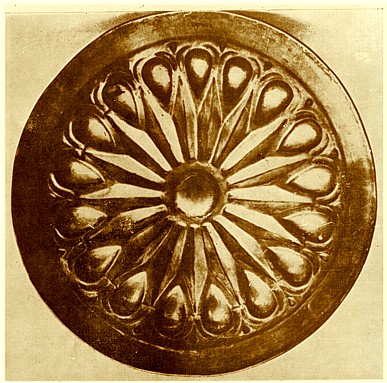
DECORATIVE PLATE WITH COSMIC SYMBOLISM -- 17 RAYS [ORION] IN THE
FORM OF DIAMOND/SPEARS EMANATE FROM THE CENTER CORE...IN
TURN 17 SACRED CONES POINT BACK TO THE SOURCE [RETURN...]
ALL WITHIN ONE ALL-ENCOMPASSING CIRCLE. FROM ERZNKA [EREZ] --
THE ALL-IMPORTANT CENTER OF THE GREAT MOTHER GODDESS ANAHIT
WHERE HER GRAND TEMPLE [AMONGST MANY OTHERS] ADORNED WITH GOLDEN
STATUES -- ONCE STOOD -- IN THE EKEŁEATS
PROVINCE [ALSO KNOWN AS
ANAHTAKAN] -- THE GREAT HEATHEN CULTURAL AND SPIRITUAL CENTER [WHERE
ARTS AND CRAFTS OF ARMENIAN MASTERS FLOURISHED FROM ANCIENT TIMES ALL
THE WAY UP TO THE FIRST HALF OF XXTH CENTURY] OF GREATER ARMENIA ON
THE RIGHT BANK OF THE SACRED EUPHRATES RIVER. ONE OF THE SYMBOLS OF
THE GODDESS WAS FAIR/WHITE DEER [PARALLEL OF DIANA AS HUNTER
GODDESS]. VITH CENTURY BC. DISPLAYED IN THE BRITISH MUSEUM.
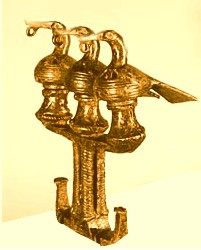
THE PRINCIPLE OF THE SPIRITUAL TRINITY OR TRIUNE [SOUL + SPIRIT +
MATTER].
UPON THE AXIS/MUNDI/WORLD PILLAR [3 COLUMNS] 3 BIRDS [SPIRIT REALM]
WITH RINGED BEAKS SITTING UPON PHALLIC-ESQUE EGGS. ALL UPON
THE CRESCENT/HORNS/HEAVENLY BOAT [CELESTIAL PRECESSION]
RITUALISTIC STATUETTE FROM KUCHAK. XVII-XVITH CENTURIES BC.
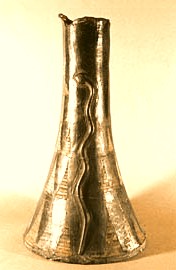
SACRED HEARTH STAND [ETERNAL FLAME]
DECORATED WITH UP AND DOWN POINTING
TRIANGLES WITH THE KUNDALINI SERPENT SEED
[LIFE FORCE] RISING TO THE TOP. LCHASHEN.
XV-XIVTH CENTURIES BC.

CEREMONIAL AXE HEAD [THE CULT OF THE AXE OR DOUBLE AXE]
WITH THE GODDESS [SPREAD ARMS]
The historical European languages—those that left literary remains— provide evidence that the dialects from which they descended had found their way into central Asia along with the Tocharians. These languages have many words in common. An example is the word for "salmon," once regarded as a weighty argument for a homeland in northern Europe. Salmon abounded in the Baltic rivers of Europe, and the word lax (German Lachs) in the Germanic languages is perhaps echoed by lak- in Hindu, for a lacquer of a pink color that evokes the color of salmon flesh. One species of salmon, Salmo trutta, is found in the streams of the Caucasus, and the lak-s- root denotes "fish" in earlier and later forms of Tocharian as well as in the ancient European languages.

FALLEN WARRIOR CREMATED ON CEREMONIAL PYRE.
ARMENIC WOMEN LAMENTING THE DEATH OF ONE OF THE
BELOVED MEMBERS OF THE FOLK COMMUNITY.
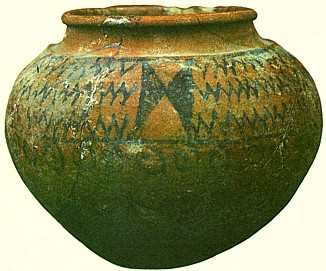
A DECORATED POT FROM AŠTARAK.
NOTE THE ANCIENT ARMENIAN SIGN OF INFINITI IN
THE CENTER. TWO VERTICAL AND TWO HORIZONTAL TRIANGLES
UNITED IN THE CENTER. ADJOINING ZIGZAG LINES ON THE SIDES
ALL WITHIN TWO PARALLEL LINES RUNNING ACROSS.
SPIRALING WAVES BELOW. SECOND MILLENNIUM BC.
The migration of the speakers of some of the early Indo-European dialects into central Asia is established by loan words from the Ugric language family, which gave rise to modern Finnish and Hungarian. Under the influence of Finno -Ugric, Tocharian underwent a complete transformation of its system of consonants.

A JAR FROM DVIN [DUIN] WITH SPIRALING HANDLES.
ELEVENTH CENTURY. NOTE THE SAME SIGN OF INFINITI
AS IN THE POT FROM AŠTARAK FROM THE SECOND
MILLENNIUM BC.
THE HOLY SYMBOL PLACED BY THE CRAFTSMEN THREE MILLENNIA LATER
IN AN UNBROKEN TRADITION. FOUR UNITED TRIANGLES POINTING TO THE CENTER.
ARCHETYPICAL SYMBOLS ARE AN INTEGRAL PART OF CONSCIOUS AND UNCONSCIOUS
MICROCOSMIC-MACROCOSMIC ESSENCE.
Words in the ancient European languages that are clearly borrowed from the Altaic and other languages of central Asia give further testimony to the sojourn of their speakers there.

AN AMULET OF PROTECTION. METSAMOR.
SECOND MILLENNIUM B.C.
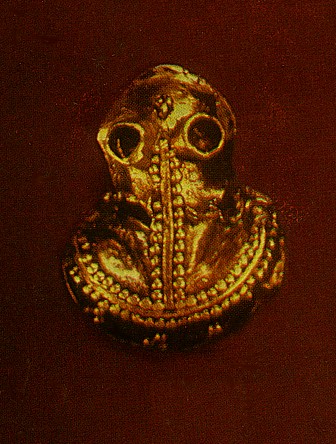
GOLDEN BROOCH IN THE FORM OF A TOAD [SHAMANIC FAMILIAR]
LCHASHEN, XIV-XIIITH CENTURIES BC.
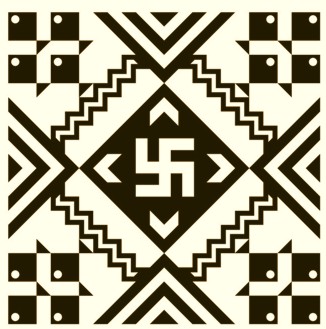
UNMANIFEST UNDERLYING I D E A L DIVINE E S S E N
C E [THE SOURCE OR
THE CORE] UNFOLDING MANIFESTING AST-AR THROUGH PHYSICAL AND
SPIRITUAL HIERARCHY. DIVINE A R T BY KAREKIN D. DICKRAN ONE OF
THE OUTSTANDING REVIVALISTS OF THE ANCIENT ARMANI SACRED PATTERNS
[THE EXTRACTION AND CONTRACTION OF THE COSMIC MATRIX
OR THE BREATH/HEARTBEAT OF THE COSMOS FROM
V I S H A P A G O R G -- OR -- DRAGON RUG]
FOR MEDITATION AND S P I R I T U A L H E A L I N G.
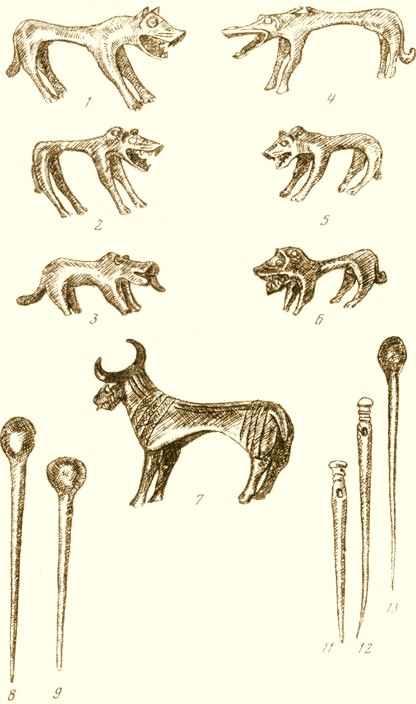
FIGURINES FROM AYRUM. SECOND MILLENNIUM BC.
1-6 CANINES. 7. TAURUS. 8-13. DRESS PINS.
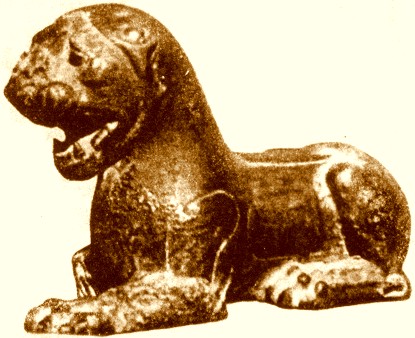
FIGURINE OF A LION FROM SYUNIK [SIWNIK']. SECOND MILLENNIUM BC.
Circling back to the west, the ancient Europeans settled for a time north of the Black Sea in a loosely federated community. Thus, it is not entirely wrong to think of this region as a second homeland for these peoples.

A R M A N NOBLEMAN BURIED WITH ENGRAVED CEREMONIAL DAGGER.
PRECIOUS GEMS AND OTHER DECORATIONS
From the end of the third through the First millennium B.C., speakers of ancient European languages spread gradually into Europe. Their coming is demonstrated archaeologically by the arrival of the semi nomadic "pit grave" culture, which buried its dead in shafts, or barrows.
![]()
WARRIOR'S SWORD FROM THE SEVAN BASIN. SECOND MILLENNIUM BC.